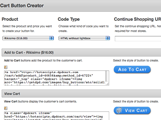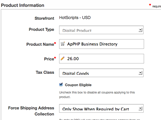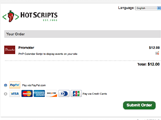DPD - Digital Product Delivery Editor's Review

Editor's rating
The editor's rating is calculated based on the average of the following criteria, rated on ascale of 1 of 5:
- Installation: 5
- Features: 4.5
- Interface: 5
- Customization: 4.5
- Help and support: 5
Bottom line
"No other digital delivery service is as inclusive and easy-to-use as DPD - Digital Product Delivery. " - Ahmad Permessur, Editor - HotScripts.com
Pros and cons
Pros
- Supports a plethora of different digital product types.
- Has a well-organized interface to manage all aspects of your store.
- Email email look and feel, as well as its copy, can be customized.
- Supports multiple store creations at no additional cost.
- Comes with a fully fledged affiliate management feature.
- Provides several integrations with your own site or third-party services.
- Can be used to sell tangible goods as well.
- Excellent email support as well as access to an extensive knowledge base.
Detailed review
Adding e-commerce support to a site takes a lot of effort. Everything from setting up a secure shopping cart to accepting payments and handling fulfillment requires near-perfect execution at each stage. Digital goods are even more challenging in some ways, since you need extra security and flexibility to protect your digital deliveries.
DPD, a hosted digital product delivery application, takes the pressure off of selling and distributing downloadable products and content subscriptions. In this review, we'll take DPD for an extensive test-drive and see how it stacks up in terms of features and competitors.
Since DPD is a remotely hosted service, there's nothing for you to download or install on servers. As such, it offers a quick time to market and eliminates maintenance cost. DPD can handle all sorts of digital products — all the way from multimedia files, ebooks, software and scripts to digital services such as event registration, accepting online donations, or invoicing personal services. While digital delivery is the most appealing feature of DPD, I even find it to be suitable for selling tangible goods thanks to its tax and shipping features.
To get started with DPD, you will need to sign up for an account. A 30-day free trial makes it very convenient for checking out its feature set and performing some no-restriction testing. After logging in the administration area, I was totally blown away by its interface — it sports a well-designed and easy-to-use interface with each section and their corresponding option sets carefully thought out. All new accounts have a default store already created, but you have the ability to create multiple stores (at no additional cost) with each one running under different parameters or with an alternate look and feel.
When you add a new product in DPD, there's a nice wizard that walks you through the process. The first step is to select the appropriate product type. You have the option to choose between digital product file or keycode delivery, activation code or URL, tangible good, service or a combination of these three.
Depending on your choice, the wizard presents relevant options. For example, with a digital product file, you will be asked to upload a copy of the file which will then be delivered via a secure and unique URL. For keycode type products, you will be able to upload a list of keys or ask DPD to auto-generate these for you. Even better, you can have the system pull keys in real-time from an external key delivery URL on your end.
As with any other shopping cart platform, you will also need to define pricing, download limit, product title and image, etc. If your product requires a license agreement that needs acknowledgment prior to purchase, you can type in one for your product and DPD will automatically prepend it to the checkout process. Finally, you can also define product variations or price points for your products and present those in a selection dropdown to end-users. All these options give you great flexibility in selling virtually anything.
The features we've reviewed so far are commonplace to most digital delivery systems, but DPD includes some others that set it apart from its competitors. Probably the one that the company stresses most is its copy-and-paste shopping cart integration — and to be honest, it is clever and well-implemented. From a section called “Button/Link Creator,” you can generate several types of links or buttons for actions such as “checkout,” “add to cart,” and “view cart.” I really like the lightbox overlay option that you can enable when products are added to a cart, as well as the instant checkout option to bypass the cart and send your visitors directly to the payment page. Thanks to these convenient link types, you can sell your products almost anywhere — from forums, to emails, and even on social networks.
A few other features are definitely worth mentioning, including coupon code support, FTP import of files, and support for several payment gateways (such as PayPal Express, PayPal Payments Pro, Authorize.net, 2Checkout, etc.). Its brilliance, though, is that it hooks with several third-party services like Google Analytics Ecommerce Tracking and a number of email service providers, such as MailChimp, AWeber and CampaignMonitor. If you want to track sales to your database, you can specify a URL that captures POST notification via HTTP each time a transaction is completed.
In terms of customizing the look and feel of your checkout process, the provided template editor allows you to edit the HTML code of your cart and checkout pages by either specifying a wrapper header and footer or pre-pending and appending text/images to specific pages.
One thing that the developers really nailed is the post-transaction section. In addition to beautiful reports with graphs, charts, and an exportable CSV file of completed transactions, they've also put together some nice marketing tools. For example, you can create newsletters to send to customers that matches certain criteria (e.g., those who purchased a specific product) as well as a full-featured affiliate program so that affiliates can promote your product and earn commissions on sales.
Finally, a new feature that DPD introduced a couple of weeks ago is its Content Subscription model. This lets you sell recurring subscriptions for access to a member-only content area of your site where you want to provide premium content or files. DPD will handle everything from the user signup, authentication, and subscription checkout to automatic billing each time payment is due. It will also take care of canceling a user’s access and subscription whenever payment is not received.
All in all, DPD marries together the idea of simplicity with a robust e-commerce platform to deliver a remarkably easy-to-use delivery solution. With a very attractive fixed monthly plan that doesn't charge you on a per-transaction basis, it definitely warrants your consideration.
Screenshots
This is an editorial review; not a recommendation. All editorial reviews, some of which we may receive compensation to perform, express our objective findings and experiences with the specific product (including version) under review. The review expressed is of the editor only. Any product claim, statistic, or other representation should be verified with the provider.



